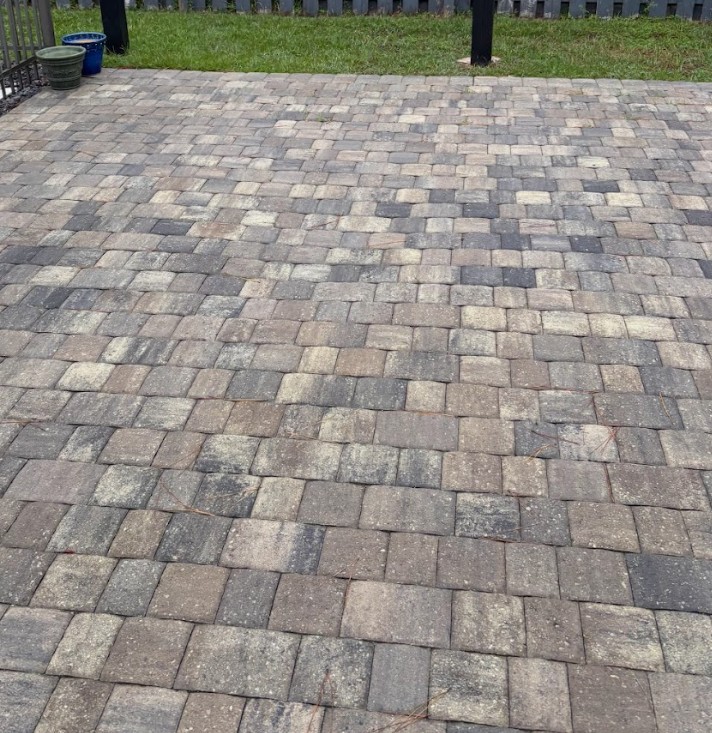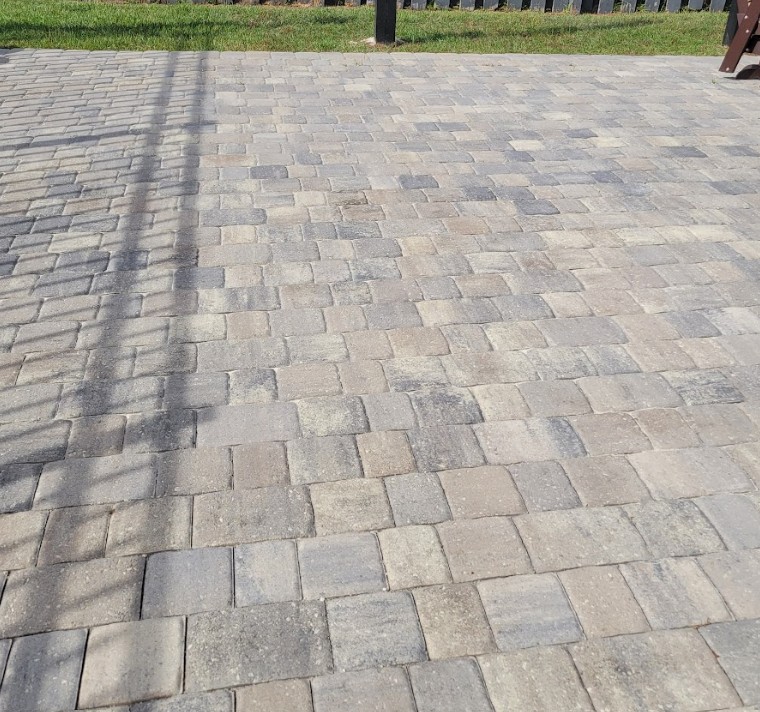Are you looking for patio repairs “Near Me?” If you live in Savannah and need a patio repair, chances are it is because something shifted or cracked. Let us explain!
A small crack in your patio may not seem urgent until it widens, someone trips, or water starts pooling where it has never done so before. In Savannah, our soil moves more than most homeowners realize, and patios shift right along with it.
Catching cracks and shifts early can save you real money and prevent a complete rebuild of your patio with just a minor patio repair. Continue reading to discover why waiting is the most expensive option and why a patio repair Savannah is much easier than you might think!
First, Why Patio Damage Is So Common in the Savannah Area:


Any guess as to why patio damage is a common issue in Savannah, GA? It has a lot to do with the soil, followed by the original patio installation.
Savannah patios sit on soil that behaves differently throughout the year. The ground expands when it absorbs moisture and shrinks again when it dries. That movement creates stress under concrete and paver systems. Add heat, humidity, tree roots from the classic coastal Oaks, and heavy rainfall, and the surface begins to shift. Even a well-built patio eventually reacts to these natural conditions over time.
Hardscaping professionals in the region observe the same patterns repeating year after year, which is why repair is so prevalent here in Savannah, Pooler, and Coastal Georgia.
Here are the main reasons patios in Savannah develop cracks, dips, and uneven areas:
1. Clay-Rich Coastal Soil Movement
Much of Savannah’s ground is made of clay-heavy soil. Clay absorbs water during humid or rainy seasons and expands as a result. When it dries, it contracts. This change in volume causes the patio base to expand and contract, gradually resulting in raised corners, sunken sections, or visible cracking. The soil never stays perfectly stable, so the patio surface moves along with it.
2. High Humidity and Moisture Retention
Savannah is humid most of the year, meaning patios absorb moisture not just from rain but also from the air. This constant exposure wears down sealants faster and softens the underlying base material. Over time, joints weaken and the patio loses its support structure, especially if drainage was not installed correctly from the start.
3. Tree Root Growth Beneath the Patio
Live oaks, magnolias, and palms have wide, spreading root systems. These roots often move under patios in search of water. As they grow, they lift slabs or push pavers out of alignment. Cutting the roots does not solve the issue because the soil shifts where the roots used to be. Professionals often rebuild the base layer to regain stability.
4. Heavy Rainfall and Runoff Patterns
Savannah frequently gets sudden downpours. If the patio does not have a proper slope or drainage channel, water collects in the base layer. A waterlogged substrate washes out, leaving hollow pockets beneath the surface. Once the support layer weakens, the patio starts to sink unevenly.
5. Heat Expansion in Summer Months
Concrete and pavers expand in high heat. During Savannah’s hottest weeks, the surface warms and expands. When temperatures cool, it contracts again. That repeated expansion cycle contributes to cracking. Contractors choose specific materials and spacing to accommodate this, but older patios often lack those adjustments.
Warning Signs You Need Patio Repairs:

How do you know if you need a patio repair? In most cases, it is pronounced.
Patio damage rarely comes as a sudden failure. It typically shows up slowly and quietly. The earlier you recognize the warning signs, the more straightforward and affordable the repair will be. Homeowners often overlook these signs until the damage becomes apparent.
Look for these key signs that you might need to fix your patio:
1. Hairline Cracks That Keep Growing
A cracked patio is one of the most common signs that you have an issue. Small cracks are normal, but widening cracks indicate the base soil is shifting. If the crack lengthens or deepens over the course of a season, the patio is actively moving.
2. Patio Sections That Feel Uneven or Tilted
A slight change in slope means the substrate has begun to settle. Even a slight difference underfoot is worth checking because it usually spreads throughout your concrete or paver patio.
3. Water Pooling on the Surface After Rain
Standing water means the patio has lost its original slope, most likely due to what is going on underneath with the soil. Water sitting on the surface accelerates wear and seeps into the base layer, causing further sinking.
4. Loose or Rocking Pavers When Walked On
When a paver wiggles or tilts, the bedding layer underneath has shifted. This is often the early stage of a larger section starting to sink, and it is repairable.
Why You Shouldn’t Wait to Repair Patio Damage
Once patio movement begins, it rarely stops on its own. The process continues with each season, making future repairs more complex and costly. Addressing the issue early maintains structure, appearance, and safety.
Here are the key reasons to act sooner rather than later:
1. Damage Spreads Faster in Savannah’s Climate
Moisture, heat, and soil expansion speed up the breakdown process. What starts as a small imperfection can spread across the patio within months.
2. Water Infiltration Weakens the Base Layer
Once water gets under the surface, it erodes the support foundation. Left untreated, the patio may sink unevenly and require full sub-base reconstruction.
3. Trip Hazards Become Safety and Liability Issues
An uneven patio creates unsafe walking conditions. This is especially important for families, guests, and older adults.
4. Repairs Cost Less When Caught Early
Resetting a few pavers or sealing a small crack is far more affordable than rebuilding multiple sections. Early repair prevents large-scale failure.
5. Maintains Home Value and Outdoor Living Appeal
Patios are key features in Savannah homes. A well-kept patio improves comfort, aesthetics, and resale value. Allowing damage to spread reduces both enjoyment and property value.
How to Find a Patio Repair Company Near Me
When searching for patio repair experts near you, start by looking for companies with proven experience in Savannah’s unique soil and climate conditions. Check recent before-and-after photos, verified reviews, and whether they offer on-site inspections. Local knowledge matters; coastal soils shift differently from those in inland areas. Coastal Hardscapes of Georgia has been repairing patios across Savannah for nearly 20 years, providing reliable and long-lasting solutions. Select a contractor who understands coastal movement, proper foundation work, and effective drainage.
Most Common Patio Repair Solutions Coastal Hardscapes Uses

Patio repairs work best when they address the cause of the damage, not just the surface appearance. In Savannah, the primary issue is typically shifting soil or moisture movement beneath the patio. The repair must stabilize the base before resetting the surface. A quick patch on top may look fine for a few months, but the same problem eventually returns. The goal is to restore support, alignment, and drainage so the patio stays level over time.
Here are the repair solutions that provide lasting results:
1. Paver Re-Leveling and Base Correction
For paver patios, sections that sink or lift are removed, the base is leveled, compacted, and rebuilt, then the pavers are replaced in the exact pattern. This restores the original finish without replacing the entire patio.
2. Joint Sand Replacement and Seal Application
Over time, joint sand washes out, and weeds begin to grow. Fresh polymeric sand is swept into the joints, and the surface is sealed. This locks pavers in place, prevents washout, and improves durability against rain and humidity.
3. Sub-Base Reconstruction
When the underlying base layer has washed out or shifted, targeted excavation and rebuilding may be needed. This provides the strongest and most stable long-term correction, especially for patios that have settled unevenly.
4. Drainage Channel or Re-Grading:
If water is collecting in one area or flowing toward the house, drainage must be corrected. Re-grading, installing proper slope, or adding a French drain helps prevent further erosion and settling.
5. Concrete Crack Stabilization and Resurfacing
Concrete cracks can sometimes be filled and reinforced if caught early. After reinforcing, a resurfacing coating restores the finish. This method only works when the base layer remains structurally sound.
The most reliable results come from a professional inspection. A trained patio repair expert understands how Savannah soil behaves through the seasons and recommends the solution that stops the movement at the source, not just on the surface.
Concrete vs. Paver Patios in Savannah
What is a better choice for a patio in Savannah, concrete or paver patios?
Your patio’s performance depends on how well the material adapts to Savannah’s changing soil and moisture patterns. Both concrete and pavers can look attractive, but they react differently when the ground moves beneath them. In our opinion, a paver patio (especially a pereamble paver patio) is a great solution for the loamy savannah soil.
Concrete Patios
Concrete creates a smooth, uniform surface. It requires less initial labor and works well when the soil remains stable. However, Savannah’s clay-heavy ground does not always stay level. When the soil moves, concrete has no flexibility. Cracks form, and those cracks tend to spread. Repairing concrete often involves patching, resurfacing, or replacing entire sections.
Paver Patios
Pavers are individual pieces set over a flexible base. When the soil shifts, the surface can be adjusted without tearing out the entire patio. If one area settles, pavers in that section can be lifted and reset. Pavers also offer more style options, including textures and patterns that complement coastal landscaping. Maintenance involves occasional joint sanding and sealing.
What is Better in Savannah, Pavers or Concrete?
Pavers typically offer better long-term value in this Coastal Georgia region because they can accommodate the soil movement. Concrete works well for smaller areas or budgets, but it has a higher chance of cracking and sinking over time, due to the aforementioned soil shifts from above earlier.
Cost Guide for Patio Repair in Savannah

Repair pricing depends on the size of the patio, the type of damage, and the amount of base rebuilding required. Simple surface fixes are less expensive, while structural corrections require more materials and labor. The goal is to restore stability, not just appearance, which is why the best repair begins with a proper inspection.
| Repair Type | Average Cost Range | Best For | Notes |
|---|---|---|---|
| Joint Sand and Seal | $350 to $1,200 | Weeds, ant trails, minor washout | Helps lock pavers in place |
| Paver Re-Leveling | $800 to $3,000 | Sunken or uneven sections | Repairs settling without full replacement |
| Concrete Crack Resurfacing | $500 to $2,500 | Hairline to moderate cracks | Improves surface appearance and texture |
| Sub-Base Rebuild | $1,800 to $6,500+ | Major sinking, erosion, repeat issues | Addresses the root cause for long-term stability |
| Full Patio Replacement | $4,000 to $15,000+ | Severe structural damage or redesign | Often chosen when upgrading to pavers |
Note: Actual pricing varies based on patio size and site conditions. Coastal Hardscapes provides clear, written estimates after evaluating the patio in person.
Final Word on Patio Repairs Savannah
Your patio is shifting, even if you haven’t noticed it yet. Day by day, the base moves with Savannah’s soil, and the surface slowly follows. Those small cracks, dips, or wobbly pavers you see now can turn into major structural issues later.
The good news?
When you catch it early, repairs are simple, affordable, and long-lasting. If you’re already searching for patio repairs near me or wondering whether it’s time to fix your Savannah patio, here at Coastal Hardscapes, we are happy to take a look.
Schedule a quick inspection with me today, and we’ll stop the damage before it spreads and get your outdoor space back to looking its best.


 7 Hardscape Maintenance Tips: How to Maintain Your Patio for Longevity and Beauty
7 Hardscape Maintenance Tips: How to Maintain Your Patio for Longevity and Beauty